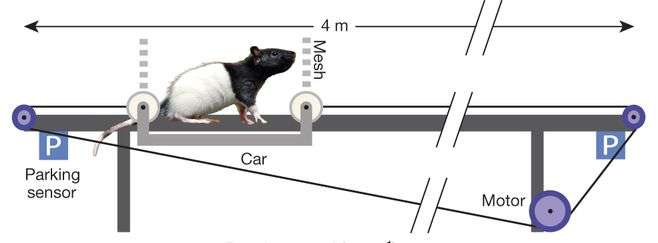July 16, 2015 report
Neurons in rat brains responsible for monitoring speed identified

(Medical Xpress)—A team of researchers working at the Norwegian University of Science and Technology has isolated the neurons in the rat brain that are responsible for monitoring speed as rats run, walk or stop moving around. In their paper published in the journal Nature, the team describes how they found the neurons and what it might mean for other mammalian brains.
Prior work by John O'Keefe back in the 70's led to the discovery of the neurons that monitor "place" and have thus been named place cells—they fire when a rat recognizes a place it has been before. Later work by some of the same team members on this latest effort led to the discovery of grid cells responsible for creating a map in the brain that allows a rat to know where it is in the world. In this new effort, the researchers have built on such prior work and have now found the cells in the rat brain that are involved when a rat moves, monitoring both velocity and angle relative to a starting point.
To make this discovery the researchers created a rat sized car that allows for monitoring neural activity while the rat uses its feet and legs to move about. The team describes it as similar to Fred Flintstone's car, of comic fame. Twenty six rats had probes placed into their brains before being put in the ratmobile. The probes (which were so sensitive they could capture single nerve activity) were inserted in a part of the brain known as the entorhinal cortex—the same general area where grid cells had been identified previously. The rats were then incited to move at different rates of speed as the team members watched. They found that a group of neurons fired in step with the speed at which the rat was moving.
The team conducted over 2,000 rat-moving sessions while studying a group of 2,497 cells, 15 percent of which turned out to be those they were looking for—the ones that would fire in ways that mimicked the speed at which the rats traveled. So clear was the response, the team reports, that they were able to accurately predict how fast a rat was moving by watching how fast its neurons were firing.
The next step, the team suggests is tying together place, grid and speed cells to better understand how the rat brain works as a whole in monitoring its sense of location.
More information: Speed cells in the medial entorhinal cortex, Nature (2015) DOI: 10.1038/nature14622
Abstract
Grid cells in the medial entorhinal cortex have spatial firing fields that repeat periodically in a hexagonal pattern. When animals move, activity is translated between grid cells in accordance with the animal's displacement in the environment. For this translation to occur, grid cells must have continuous access to information about instantaneous running speed. However, a powerful entorhinal speed signal has not been identified. Here we show that running speed is represented in the firing rate of a ubiquitous but functionally dedicated population of entorhinal neurons distinct from other cell populations of the local circuit, such as grid, head-direction and border cells. These 'speed cells' are characterized by a context-invariant positive, linear response to running speed, and share with grid cells a prospective bias of ~50–80 ms. Our observations point to speed cells as a key component of the dynamic representation of self-location in the medial entorhinal cortex.
© 2015 Medical Xpress


















